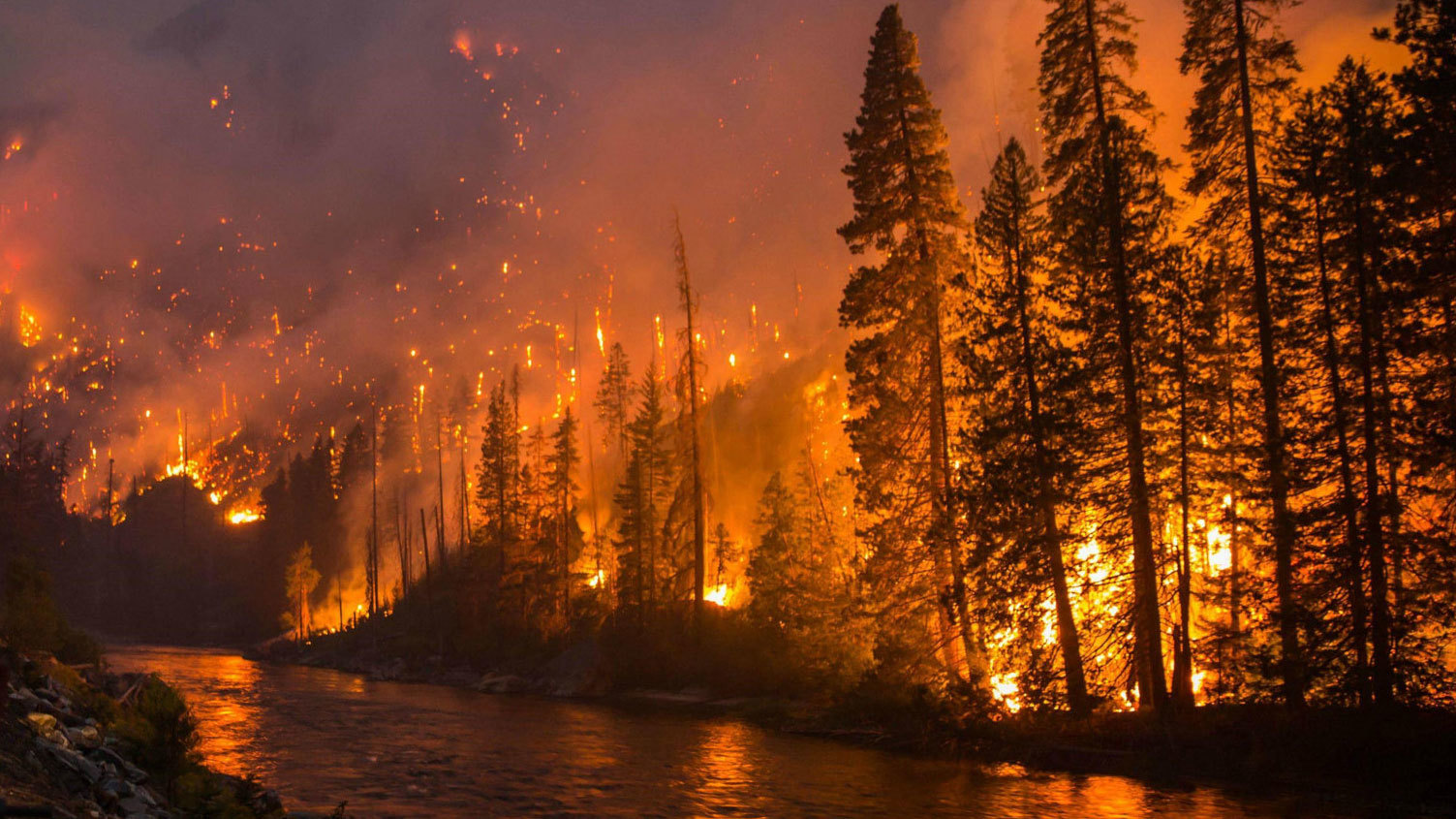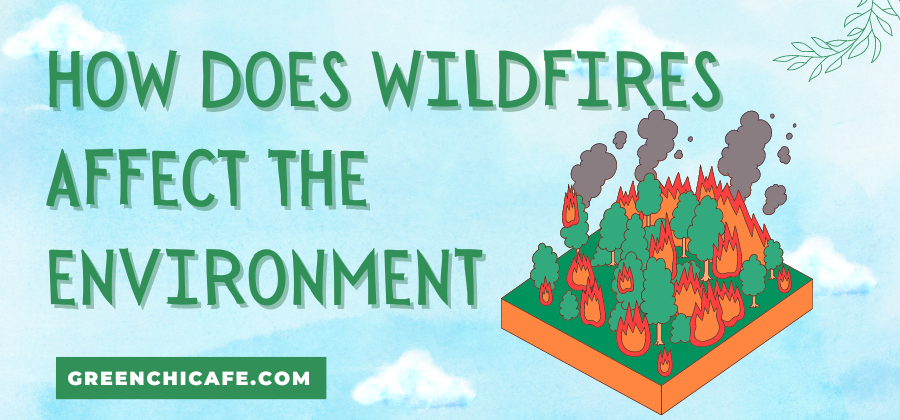Wildfires can have a devastating effect on the environment.
They destroy habitats, alter ecosystems, and release large amounts of carbon into the atmosphere.
In this article, we’ll explore the complex relationship between wildfires and the environment and look at both their short-term and long-term impacts.
How Do Wildfires Affect the Environment?

Wildfires have an overwhelmingly negative effect on the environment.
They, directly and indirectly, damage ecosystems, habitats, soil, water, air quality, climate, and human health in complex but significant ways.
While low-intensity, periodic wildfires are a natural phenomenon, today’s unprecedented mega-fires are catastrophically disruptive.
Key Points
- Wildfires incinerate vegetation, destroying wildlife habitat and food sources
- They expose soils and increase erosion, degrading land, and aquatic habitats
- Fire smoke contains hundreds of pollutants that reduce air quality and harm health
- Wildfires release immense amounts of greenhouse gases, accelerating climate change
Why Do Wildfires Start in the First Place?
Wildfires are a natural part of many ecosystems.
However, human activity has dramatically increased its frequency and intensity in recent decades.
The main causes of wildfires include:
- Lightning strikes
- Accidental human causes like unattended campfires or discarded cigarettes
- Intentional arson
- Sparks from machinery and infrastructure
Climate change is also exacerbating wildfires by creating hotter, drier conditions that make vegetation more flammable.
So, while wildfires are a natural phenomenon, human activity has made them more destructive.
How Do Wildfires Affect Vegetation and Habitats?
The most immediate effect of wildfires is the destruction of vegetation.
Flames can incinerate grasslands, shrubs, trees, and forests in a matter of hours or days.
Frequent, high-severity fires prevent vegetation from fully recovering between burns.
Over time, this can permanently alter ecosystems by shifting the plant species’ composition.
For example, frequent fires may convert forests to grasslands because the trees cannot reestablish themselves quickly enough between burns.
This results in a loss of forest habitat for many wildlife species.
Slow-growing plants with thin bark like mature trees are especially vulnerable.
Fire can also stimulate new growth by releasing soil nutrients.
But if fires are too frequent, those nutrients won’t have time to rebuild, resulting in less productive soils.
Ultimately, the vegetation impacts depend on the fire intensity, frequency, and ecosystem type.
How Do Wildfires Affect Wildlife and Biodiversity?
The loss of vegetation from wildfires also destroys vital habitats and food sources for wildlife.
Slow-moving animals have little chance of escaping rapidly spreading flames.
And even those that survive may starve due to lack of food and shelter.
Large, severe fires can fragment forests and grasslands.
This fragments the population of species and disrupts migration routes.
Fragmented habitats may lack sufficient food and shelter to support sustainable populations.
However, not all wildfire impacts on wildlife are negative.
Periodic fires help maintain habitats for fire-adapted species like the black-backed woodpecker.
Low-intensity “mosaic” fires create landscape patchiness that supports higher biodiversity.
But modern mega-fires are so large and severe that they overwhelm those benefits.
Overall, biodiversity decreases as fire frequency and severity increase beyond historical levels.
And habitat fragmentation due to expanding human infrastructure exacerbates wildfire habitat impacts.
How Do Wildfires Affect Soil Health and Stability?
Wildfires burn off vegetation cover and organic matter in soils.
This leaves soils vulnerable to erosion from wind and rain.
Erosion removes fertile topsoil and carries sediments that damage fish habitat in rivers and lakes.
Hillside soils can erode downslope, causing landslides and debris flows.
Frequent high-severity fires also reduce soil stability by burning away organic matter that binds soil particles together.
This process, known as water repellency, sets the stage for floods and mass soil erosion during the rainy season.
But some soil nutrients like nitrogen and phosphorus become more available after the fire, stimulating regrowth.
Fire can also make soils less able to hold water due to vaporization, increasing runoff.
But runoff also carries nutrients that stimulate aquatic productivity.
So again, impacts depend on fire characteristics like severity, size, and frequency.
How Do Wildfires Affect Water Resources and Aquatic Habitats?
As mentioned above, wildfires greatly increase runoff and erosion rates.
Sediments and debris washing into rivers smother fish eggs and aquatic insect larvae.
Sediments also make water murkier, which reduces the light penetration that aquatic plants need for photosynthesis.
Murky waters caused by fire sediments can persist for months after the fire is out.
In addition to sediments, fire retardants and heavy metals like mercury wash into waterways and harm aquatic life.
However, nutrients in runoff can also boost algal growth and stream productivity after fire.
So again, impacts are complex, depending on fire severity and watershed characteristics.
How Do Wildfires Affect Air Quality?
Wildfire smoke contains hundreds of chemicals and particulate matter that reduce air quality and harm human health.
Smoke pollution can drift hundreds or even thousands of miles downwind of a fire.
A 2020 study found that 652,000 deaths worldwide each year are associated with exposure to landscape fire smoke.
Groups like infants, the elderly, and those with respiratory conditions are especially vulnerable.
Carbon monoxide, nitrogen oxides, volatile organic compounds, and carcinogens in smoke all reduce air quality during and after fires.
Smoke also increases the atmospheric load of climate-warming black carbon.
Overall, wildfire smoke has pronounced public health and air quality impacts that can extend far beyond fire perimeters.
How Do Wildfires Affect the Climate?
Wildfires release immense amounts of carbon dioxide into the atmosphere through the combustion of vegetation and soil organic matter.
They also reduce forests’ ability to absorb CO2 from the atmosphere.
This creates a positive feedback loop where fires release more greenhouse gases, driving further warming that worsens fire conditions.
Fires also release black carbon, methane, and reactive organic gases that trap heat, magnifying their warming effects.
Studies estimate that wildfires currently contribute up to 10% of total global carbon emissions per year, further accelerating climate change.
Earlier snowmelt and hotter, drier summers due to climate change cause soils and vegetation to dry out earlier, lengthening wildfire seasons.
While climate change does not start wildfires, it increases their frequency, intensity, and extent through hotter, drier conditions.
So, climate change and mega-fires form a vicious cycle.
How Long Do Wildfire Impacts Last?
Some wildfire effects are immediate, like destruction of vegetation and loss of wildlife.
Other impacts can persist for years or decades.
For example, erosion and flooding may increase for 5 years or more after a big fire.
Markedly increased runoff and sediment loads can last up to 25 years.
Reduced biodiversity and soil productivity can endure up to a century.
And large, severe fires may permanently convert some forests into non-forested ecosystems.
Similar long-lasting effects are possible for aquatic habitats, air quality, and the climate.
What Environment is Most Affected by Wildfires?
Forest ecosystems are arguably the most affected by today’s mega-fires.
Historically, low to moderate-intensity fires played a vital ecological role in many forests.
But modern fire suppression and climate change have greatly increased fire severity, size, and frequency.
Severe fires permanently alter forest structure by removing older, larger trees and shifting species composition.
This eliminates habitat for specialist forest-dwelling species, reducing biodiversity.
Frequent high-intensity burns prevent forest regeneration between fires.
Ultimately, today’s uncharacteristic mega-fires are converting millions of forested acres into non-forested habitats unsuitable for many species.
This forest “type conversion” affects both public and private lands across fire-prone regions worldwide.
While other habitats like grasslands are also impacted, it is unprecedented fire activity in forest ecosystems that garners the most scientific and public concern.
How Does Wildfires Positively Affect the Environment?
When under historical norms for frequency and severity, wildfires generate some ecological benefits.
Low-intensity surface fires remove accumulated woody debris and undergrowth while leaving large trees intact.
This restores forests to more open, early successional conditions favored by deer, birds, and understory plants.
Some plant seeds require fire cues to germinate. By creating landscape patchiness, fires also increase habitat diversity for edge-adapted wildlife.
Black-backed woodpeckers, for example, specialize in recently burned forest patches.
Fire converts plant biomass to fertilizing ash and stimulates nutrient cycling.
By removing competition, fire often boosts the growth of remaining vegetation.
Periodic burns were a vital process in fire-adapted ecosystems.
But modern mega-fires have grown so large and severe that they now overwhelm and destroy habitats.
In general, historical wildfire regimes had an overall net benefit, while today’s fires have a net negative impact.
How Does Prescribed Burns Help?

Prescribed or controlled burning is the intentional use of fire under specified conditions to meet ecological objectives.
When practiced carefully, it can mitigate some harmful impacts of current wildfire regimes.
For example, prescribed burns can remove excess fuels like brush and small trees that intensify wildfires.
This helps restore forests to more natural conditions shaped by frequent low-intensity fires.
Other benefits include enhancing habitat for fire-adapted species, recycling nutrients, and maintaining meadows and grasslands.
However, prescribed fire projects must be thoughtfully planned and implemented based on historical practices to avoid further ecosystem degradation.
Used judiciously along with other fuel treatments, prescribed fire remains an important tool for reducing wildfire hazards.
Key Takeaways on Wildfire Impacts
In summary, it’s clear that wildfires have pronounced impacts on the natural environment in complex ways:
- Vegetation is directly incinerated and regrowth suppressed, altering habitats
- Wildlife populations and biodiversity decrease due to habitat loss
- Soils are exposed and destabilized, increasing erosion and floods
- Water bodies are smothered with sediments, debris, and contaminants
- Air quality is severely degraded during and after fires
- The climate is warmed through greenhouse gas and black carbon emissions
- Some impacts last for years or even decades after the flames subside
While wildfires are a natural phenomenon, their current unprecedented frequency, intensity, and extent are proving catastrophically disruptive to ecosystems and human health.
Only by understanding their intricate environmental impacts can we hope to develop solutions and minimize harm.
This overview provides a starting point for that vital discussion.
Frequently Asked Questions
How Long Do Wildfire Impacts Last?
Some wildfire impacts like habitat destruction are immediate, while others like increased flooding can last over 25 years. Reduced biodiversity and soil productivity may endure up to a century. Large, severe fires can also permanently convert forests into grasslands or shrublands.
Do Controlled Burns Help Mitigate Wildfire Impacts?
Yes, controlled or prescribed burns can reduce wildfire severity by removing excess woody debris and undergrowth. But they must be done carefully based on historical fire patterns to avoid further habitat degradation.
What Can Be Done To Minimize Wildfire Impacts?
Strategies include fuel reduction thinning, harvesting smaller trees, creating fuel breaks, and using prescribed fires. Reducing human-caused ignitions, smart growth planning, and hardening homes against fire are also important.
Why Are Today’s Wildfires More Damaging?
Increased human ignitions, fire suppression policies, climate change, and expansion of homes into fire-prone wildlands have increased wildfire frequency, size, and severity compared to historical norms. This exacerbates environmental impacts.
At GreenChiCafe, we are passionate about our amazing planet and protecting our natural world. Check out our website for more great content on environmental topics.

Annie is a passionate environmental writer and activist. She has been writing about sustainability, conservation, and green living for over 15+ years. Annie is dedicated to raising awareness about environmental issues and providing practical tips for living an eco-friendly lifestyle. When she’s not writing, you can find her volunteering with local environmental organizations, teaching workshops on zero waste living, or exploring nature. Feel free to get in touch with Annie: annie@greenchicafe.com
